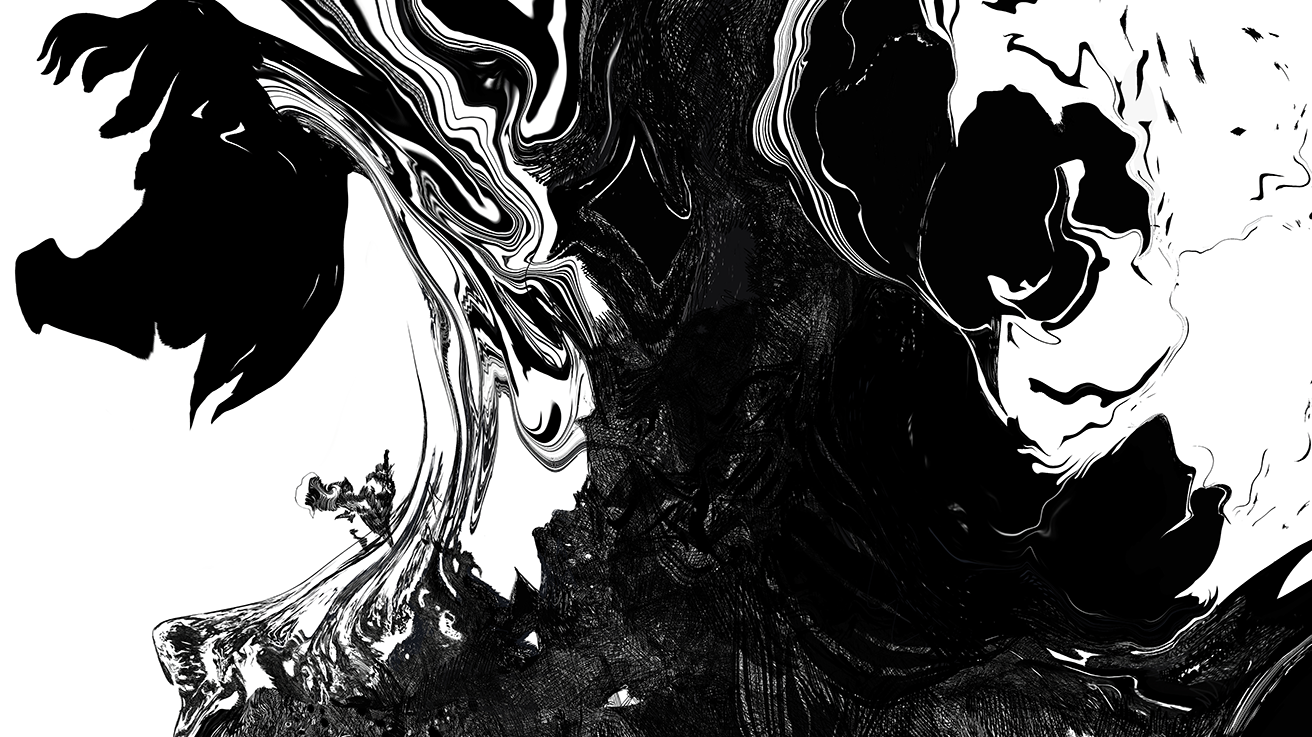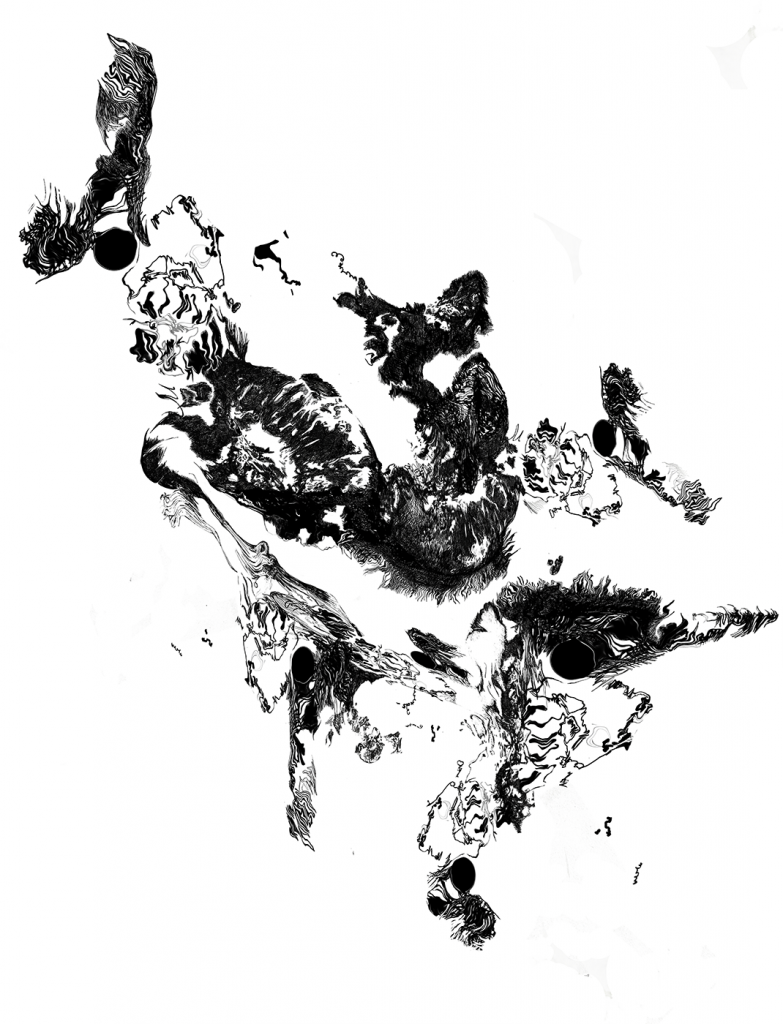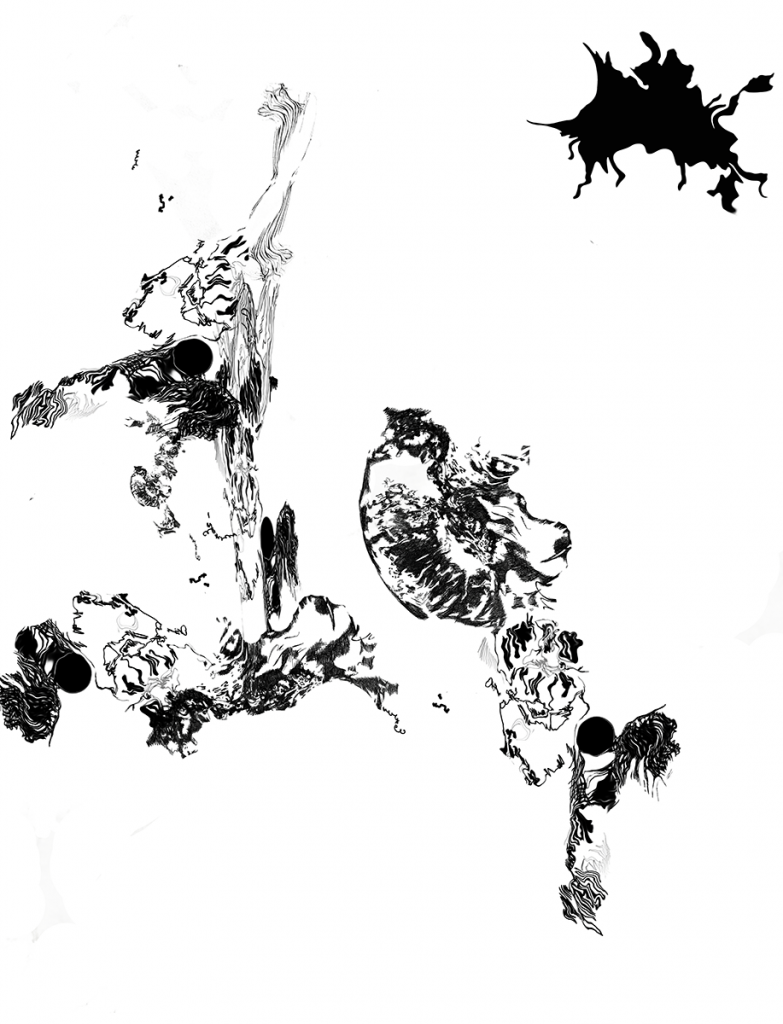Rachel Rose on Formlessness
Rose's drawings result from meditative sessions in which she uses the flexibility of her digital medium to shift perspective and scale.

Rachel Rose is best known for her video works, where montage builds formal and philosophical relationships between images and places. “Enclosure,” a project commissioned by LUMA Arles and the Park Avenue Armory and recently presented at Gladstone Gallery in New York, traces connections between eighteenth-century landscape painting and contemporaneous efforts, often violent, to acquire land. Her digital drawings also follow processes of juxtaposition and shifting perspective. But if in the videos these relationships unfold over time, then in the drawings they are compressed in space, creating dense tangles of intuitive associations that darken the screen’s bright blankness. Her new series, L’informe, takes its title from a concept of formlessness introduced by French philosopher Georges Bataille, which art historians have interpreted to describe how abstraction is experienced by the mind and body. In the below exchange, which took place over email, Rose tells Outland’s artistic director how she dug into her image archives to find forms, then undid and remade them in intense, meditative drawing sessions.

CHRISTOPHER Y. LEW The new NFTs you created are from very personal drawings and, in some ways, they are biographical works. Is it fair to say that these were very intuitive pieces? And that it took some time after they were made to understand what they are?
RACHEL ROSE Totally, I started making these works this past summer when I had severe postpartum depression. While it lasted, drawing was one of the few things that helped. I had been making drawings on my iPad before this for some time, but differently, and they were the basis for physical works—engravings. For the series Enclosure I-VIII I collaged previously existing drawings together, pulled from an archive that spanned over five hundred years, and then use the iPad to erase and draw over the lines that were there. I was surgically suturing together lines from different eras and different hands, like an early Disney cel merging with a da Vinci. These digital compositions I would then translate back into the physical world by making them into copper etchings and working with a master engraver to turn them into gravures. This technique of weaving the digital through an analogue printing process created a feeling of not really knowing how the works came to be. But L’informe was different, because while the first one began by drawing on top of a Dürer engraving of a forest that I had used in one of these previous composite engravings, the works quickly unfolded into their own compositions. I worked compulsively, but with no real sense of what they were or where they were going.
LEW I love how your Palimpsest etchings (2015) are not just built on your archive of images but each one also includes elements from the last. Did that happen with the L’informe drawings? Did the composition of one lead to the next or were they made independent of one another?
ROSE Mostly they were independent of one another, but at least once in each drawing I migrate a line or sliver of a section from the previous drawing, and then rework from there.
LEW Each drawing is so intricate. How much time did you spend on each one?
ROSE I think each one took about thirty or forty hours, maybe some longer. Sometimes I would work on them daily, and other times I’d stop and restart a week later. Generally I’d work in chunks of four to six hours, which felt like the right amount of time to get in, navigate, and get lost in the drawing’s world.
LEW I wanted to get your thoughts on one difference between these and the Enclosure I-VIII series. Those were made in dialogue with a master engraver, and these new drawings were done alone and in a state, if I can venture to say, of relative isolation.
ROSE The Enclosure drawings were for a book I was doing related to the production of the film, so they were in complete dialogue not only with the engraver, but with the publisher of the book. The engraver would give me direct notes on the drawings, what would need to change to achieve which effect. And then when we worked together, I would actually amend them on the copper plate itself, too. Making these new drawings, I never expected to do anything with them, making them really was simply a way to get through the day, for myself.

LEW Is that what led you to Bataille’s idea of l’informe or formlessness, from which you’ve titled these works? The drawings are as much a kind of un-doing as they are built up with repetitive strokes?
ROSE Yes, I showed a friend one of the drawings early on, and he immediately sent me back to Bataillie’s l’informe. It was spot on, because I felt like the text articulated this thing about energy I was feeling. I felt totally withdrawn, the depression blurring the energy flows of everyday life that normally have a rhythm, a form, into a formlessness. These drawings concretized that state for me. Bataille thought that the universe might be “formless like a spider, or a glob of spit” —these drawings sort of resemble things like spider webs and spit.
LEW I like the connection to a spider’s web. To me these drawings are each a world unto themselves where you can get lost within them, zooming in further and further. Are you open to these interpretations rather than insisting they are viewed as purely abstract works?
ROSE Totally. The idea of formlessness is that it stands outside of the binary between form and content, and because making these was born out of pure crisis, and I just drew—I didn’t think at all about what the drawings might resemble. But there were subliminal themes and images coming out as I made them— they feel a lot like forests to me. I really worked on them all over, panoramically—I gave no preferential treatment to one section over another. All aspects had equal value, I might have spent a day on a square inch of one of them, and another day on a centimeter, and that’s something that drawing on the iPad enables — you can zoom in as close as the scale of a pixel, and showing them on the screen really highlights the material of the form.
LEW With these digitally native drawings, you said you spent some time thinking about the best way to present them. Can you describe that thought process and how you arrived at minting them as NFTs?
ROSE I like that on the computer, the viewer can zoom in as far in as I made them, see the lines at the most micro scale, the drawings within the drawings. Because these were made on a screen, it feels natural for them to be dispersed through it. That they then live on the blockchain, a system without a center, feels reflective of the energy in which they were made.
